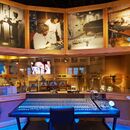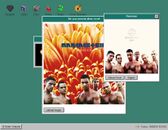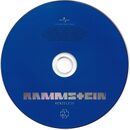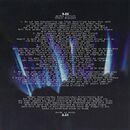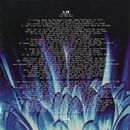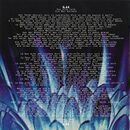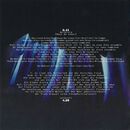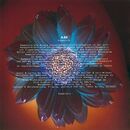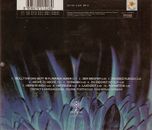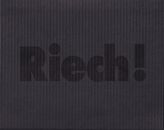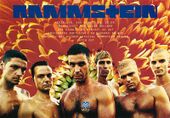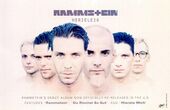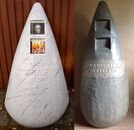Entstanden aus einem Urknall, einer Dringlichkeit, die alle sechs Musiker gleichermaßen ergriffen hat, wollen sich Rammstein als unteilbare Einheit verstanden wissen. Alle Beteiligten haben immer schon Musik gemacht, die mit dem heutigen Rammstein-Sound nichts gemein hatte. Im Osten haben sie die Arbeitsverpflichtungen ignoriert und in den Nischen existiert.
"Freie Wildbahn" nennen sie das heute - im Unterschied zum "Safari-Park" des wiedervereinigten Deutschlands, in dem "manchmal jemand vorbeikommt, der ein bisschen Futter hinwirft." Aber ein bisschen Futter macht bekanntlich auch nicht satt. Die Rammstein-Musiker stammen aus Ost-Berlin und Schwerin - "das ist im Norden", erklären sie noch heute hilfsbereit, als handelte es sich um ein ganz fremdes Land. Rammstein ereignete sich mit einer ungeheuren Wucht, die in der Musik und den Texten gleichermaßen aufgehoben ist. Zugleich mit der Gründung der Gruppe brachen alle Partnerschaften der Musiker auseinander und auch die allgemeinen Lebensumstände gaben Anlass zum Rammstein immanenten Zorn.
Rammstein schreiben sehr expressive Texte in einer wundersam unmittelbaren Sprache. Bildermächtig und harsch drängen sie zum größtmöglichen Ausdruck, zum reinen Gefühl, getrieben von ihrer ganz eigenen musikalischen Mischung aus programmierten Beats und Metalelementen, die sie selbst gerne als 'Tanzmetall' bezeichnen. Rammstein ist ein Appell an die pure Emotion und gelangt unweigerlich zum Ziel.
In Äußerungen wie: "Ihr wollt das Bett in Flammen sehen/Ihr wollt in Haut und Haaren untergehen/Ihr wollt doch auch den Dolch ins Laken stecken/Ihr wollt doch auch das Blut vom Degen lecken/Sex ist eine Schlacht/Liebe ist Krieg", und "Du riechst so gut/Ich geh Dir hinterher/Gleich hab ich Dich", liegt eine stoische Unbedingtheit. Das ihre Texte "sehr trivial" seien, ist kein Understatement. Aus der Sicht von Rammstein handelt es sich um "kleine Liebkosungen", um "Liebeslieder, auf vielleicht dekadente Weise." Auf die Frage, wie denn solche Texte entstehen, antwortet Rammstein lakonisch: “Auf der Schreibmaschine" Charles Baudelaire oder auch Brent Easton Ellis haben in Rammsteins Leben keine Rolle gespielt. Sie schreiben ihre Texte intuitiv, ohne Vorbilder Die deutschen Expressionisten will man eine Weile gelesen haben, bis man keine Zeit mehr hatte. Das ist wohl der Unterschied zwischen einer gelehrten und einer schöpferischen Begabung: Rammstein verwalten nicht die Halden der Literaturgeschichte, sie kübeln Sprache aufs Papier, als wäre es zum ersten (und zum letzten) Mal.
Vielleicht sind Rammstein tatsächlich blind für das eigene Werk. Fakt ist aber, daß "über manches nicht gesprochen werden sollte, um den Zauber der Musik nicht zu zerstören."
Fakt ist auch, daß Rammstein mit ihrer monolitihischen Metalmusik, ihren repetitiv-hypnotischen stählernen Klangmassen, dem theatralisch-gebieterischen Gesang und ihren Texten schon im Vorfeld einiges Aufsehen erregt haben. Bereits mit den ersten Demos gewannen sie 1993 eine Studioproduktion, 1994 eroberten sie mit ihrer ekstatischen Liveshow den Osten und ihren Wunschproduzenten Jacob Hellner, der nach einem Gig im Hamburger Logo spontan die Produktion von Herzeleid zusagte‚ obwohl er kein Wort deutsch verstand.
Eingespielt wurde Herzeleid im April/ Mai im Stockholmer BomKrash-Studio. Gemixt im Juli im Hamburger Chateau du Pape.
Und alle Beteiligten sind sich einig:
Herzeleid ist ein wegweisendes Debüt und Rammstein ein Rausch, den man einfach zulassen muß.
"Der Wahnsinn ist nur eine schmale Brücke/ Die Ufer sind Vernunft und Trieb" Das ungefähr ist die Quintessenz aus zweitausend Jahren Philosophiegeschichte.
Herzeleid (album)
More actions
Herzeleid is the debut album by Rammstein. It was released on 25 September 1995, and on 24 November 1998 in North America.[1]
label_quick_facts:Herzeleid (album)
March 1995
Tuesday, 24 November 1998 [North America]
Rammstein studio album chronology
| Herzeleid | Sehnsucht |
| 1995 | 1997 |
Singles off Herzeleid
| 1. Du riechst so gut | 24 August 1995 |
| 2. Seemann | 8 January 1996 |
| 3. Du riechst so gut '98 | 17 April 1998 |
| 4. Asche zu Asche | 30 August 1999 |
Music videos off Herzeleid
| 1. Du riechst so gut | 25 March 1998 |
| 2. Seemann | 8 January 1996 |
| 3. Rammstein | 4 April 1997 |
Information
Recording
The band started recording the album at Polar Studios in Sweden. For about two weeks, the band and their producers, Jacob Hellner and Carl-Michael Herlöfsson, recorded most of the drums and bass, as well as some of the guitar parts. Additionally, they worked on computer stuff to sample guitars and create sample sounds. After leaving Polar Studios, they all went to the private studio of Jacob and Carl-Michael. During their time in the new studio, they recorded the guitars and did additional recordings. The vocals were also tracked at the new studio, with Till working closely with Jacob, while Carl-Michael focused more on programming and sampling. During these recordings, the band wanted to have the line "Der Wahnsinn" in Du riechst so gut to sound as if it came from a telephone. So, one of the band members went out to a Stockholm subway, wearing nothing but a white t-shirt, suspenders, boots, and shorts. From the subway, he called the studio and repeated the line "Der Wahnsinn" over and over again in different intonations. Suddenly, he heard someone next to him calling the police, reporting a madman shouting German phrases into a phone.
The first mix, done by Jacob and Carl-Michael, took place at the MFG Studios. During these initial mixing sessions, Richard was the only band member present. However, he wasn't satisfied with the results and promptly called all other band members, the management, and the label. Together, they decided they needed a different person for the mix, leading to the agreement on Ronald Prent. When the label contacted Ronald, he happened to be on holiday on the island of Crete in Greece. After being contacted, Ronald talked to Jacob, who coincidentally was also in Greece at the same time. Together, they traveled to Hamburg and attempted to mix the album at Chateau du Pape Studios. The entire band was present during the new mixes. They decided to start with one song and create as many versions of the mix as possible. After each new mix was completed, the band left the studio to discuss outside. At one point, they requested to be mixed in a way that made them sound like Bon Jovi. However, upon hearing the result, they rejected that version. Then, Ronald had the idea of using a specific type of compression that would make the music more dry and "in your face." Upon hearing this mix, the band collectively agreed that this was the Rammstein sound they desired.[2]
Before finally settling on the title "Herzeleid," the album had the working titles "Rammstein"[3] and "Heirate mich."[4]
The first press listening of the album took place at the Chateau Du Pape studio. Music journalist Matthias Mineur was invited by Motor Music to listen to the songs and assess whether the band could indeed become the next big thing. Four weeks later, the band held an open press conference in the "Blow Up" cinema in Berlin. A black and white silent film was shown on the screen, while the band sat on chairs inside the cinema, not in front of the screen where the journalists were seated. The band consistently answered questions from left to right, regardless of who was asked.[5][6]
-
© Åke E:son Lindman
Polar Studios recreation in the ABBA museum
Other songs
Jacob Hellner mentioned in an interview, that they recorded a total of 18 songs in six weeks.[7] Based on our current knowledge of songs, the other seven recorded songs could be the following, of which only Feuerräder is confirmed:
Promotion
The promotion of the then-upcoming album initially involved three different tapes: 3-Track Demo 3, 6-Track Demo 3 and 6 Rough-Mixes/3 Mixes. These tapes were distributed by Motor Music. Once the album and the first single, "Du riechst so gut," were manufactured, the album was released as a promotional item in the "Riech!" box. This box included either the album alone (sometimes only the single, sometimes both), a small bottle of the perfume "Obsession" by Calvin Klein, and various sets of promotional sheets about the album. Below is the text from one of these sets of promotional sheets:
Born out of a big bang, an urgency that gripped all six musicians equally, Rammstein want to be understood as an indivisible unit. All involved have always made music that had nothing in common with the Rammstein sound of today. In the East, they ignored work obligations and existed in niches.
They call it "free range" today - in contrast to the "safari park" of reunified Germany, where "sometimes someone comes along to throw a little food." But a little bit of food doesn't make you full, as we all know. The Rammstein musicians come from East Berlin and Schwerin - "that's in the north," they explain helpfully even today, as if it were a completely foreign country. Rammstein happened with a tremendous force, which is equally suspended in the music and the lyrics. At the same time with the foundation of the group all partnerships of the musicians broke apart and alsothe general life circumstances gave cause for the Rammstein immanent anger.
Rammstein write very expressive lyrics in a wondrously immediate language. Imagery-powerful and harsh, they push for the greatest possible expression, for pure feeling, driven by their very own musical mixture of programmed beats and metal elements, which they themselves like to call 'dance metal'. Rammstein is an appeal to pure emotion and inevitably gets there.
In statements like: "Ihr wollt das Bett in Flammen sehen/Ihr wollt in Haut und Haaren untergehen/Ihr wollt doch auch den Dolch ins Laken stecken/Ihr wollt doch auch das Blut vom Degen lecken/Sex ist eine Schlacht/Liebe ist Krieg" and "Du riechst so gut/Ich geh Dir hinterher/Gleich hab ich Dich" there is a stoic unconditionality. That their lyrics are "very trivial" is not an understatement. From Rammstein's point of view, they are "little caresses," "love songs, in a perhaps decadent way." When asked how such lyrics come about, Rammstein answers laconically: "On the typewriter" Charles Baudelaire or even Brent Easton Ellis have played no role in Rammstein's life. They write their texts intuitively, without models The German expressionists want to have read for a while, until they had no more time. This is probably the difference between an erudite and a creative talent: Rammstein do not manage the heaps of literary history, they pour language onto paper as if fo'Perhaps Rammstein are indeed blind to their own work. But the fact is that "some things should not be talked about, in order not to destroy the magic of the music."
It is also a fact that Rammstein caused quite a stir with their monolithic metal music, repetitive-hypnotic steel sound masses, theatrical-commanding vocals and their lyrics. Already with their first demos they won a studio production in 1993, in 1994 they conquered the East with their ecstatic live show and their dream producer Jacob Hellner, who after a gig at the Hamburg Logo spontaneously agreed to produce Herzeleid even though he didn't understand a word of German.
Herzeleid was recorded in April/May at BomKrash Studio in Stockholm. Mixed in July at Chateau du Pape in Hamburg.
And everyone involved agrees:
Herzeleid is a groundbreaking debut and Rammstein is a rush that you just have to let happen.
"Der Wahnsinn ist nur eine schmale Brücke/ Die Ufer sind Vernunft und Trieb" That is about the quintessence of two thousand years of philosophical history.
Menhir
As a promotional item, 50 select record stores received a Rammstein menhir.. It stands about 140cm high and is approximately 60cm thick at its thickest part. Both the front and back of the menhir feature spaces for about three to five CDs each. The letters "Rammstein Herzeleid" are prominently displayed on both the front and back. The menhir is made of plastic. Although it has been sold a few times on eBay, it remains one of the rarest promotional items of Rammstein. There are two general variants: one painted in the common browns and greys of a rock, and another that appears to be pure white with grey dots and marker pen scribbles. The grey variant adheres to the standard dimensions (140cm high, 60cm thick), but the white variant appears to be much larger at its thickest part.
XXV Edition
The teasing for the re-release of the album "Herzeleid" commenced on September 21, 2020, when the official Rammstein Facebook page changed its header image to a rotating flower.[8] On the same day, the official website underwent a transformation, resembling a retro computer interface reminiscent of Windows 95. This revamped website featured a variety of archival materials, including newspaper articles from 1994 to 1996, live photos, photoshoot pictures, and even the game Snake. Alongside these features, the website announced the upcoming release of a remastered XXV edition of the album, celebrating its 25th anniversary.
The XXV Edition of "Herzeleid" was released on December 4th, 2020.
As part of the website's interactive experience, a competition was held, challenging participants to discover the password that would grant access to the "Privat" folder. The password was broiler1995. The prize for the competition was an original "Herzeleid" award presented to Paul.
The XXV Edition is available in both CD and vinyl formats, housed in a cardboard box. The CD version comes in a digipak case and features a new remaster of the album. Additionally, a high-quality 24-bit download of the remastered album is also available.[9] The vinyl edition of the XXV release features the previous 2015 remaster, which was initially presented in the XXI box set.
The website herzeleid25.rammstein.de has since been taken down.
-
Retro Rammstein website -
Paul's Herzeleid award
Tracklist
- Wollt ihr das Bett in Flammen sehen - 05:17
- Der Meister - 04:08
- Weisses Fleisch - 03:35
- Asche zu Asche - 03:51
- Seemann - 04:48
- Du riechst so gut - 04:49
- Das alte Leid - 05:44
- Heirate mich - 04:44
- Herzeleid - 03:41
- Laichzeit - 04:20
- Rammstein - 04:25
Europe
-
1. Wollt ihr das Bett in Flammen sehen - 05:14
2. Der Meister - 04:08
3. Weisses Fleisch - 03:35
4. Asche zu Asche - 03:51
5. Seemann - 04:40
6. Du riechst so gut - 04:49 -
1. Das alte Leid - 05:44
2. Heirate mich - 04:44
3. Herzeleid - 03:41
4. Laichzeit - 04:20
5. Rammstein - 04:25
USA
-
1. Wollt ihr das Bett in Flammen sehen - 05:14
2. Der Meister - 04:08
3. Weisses Fleisch - 03:35
4. Asche zu Asche - 03:51
5. Seemann - 04:40 -
1. Du riechst so gut - 04:49
2. Das alte Leid - 05:44
3. Heirate mich - 04:44
4. Herzeleid - 03:41
5. Laichzeit - 04:20
6. Rammstein - 04:25
-
1. Wollt ihr das Bett in Flammen sehen - 05:14
2. Der Meister - 04:08
3. Weisses Fleisch - 03:35 -
1. Asche zu Asche - 03:51
2. Seemann - 04:48
3. Du riechst so gut - 04:49 -
1. Das alte Leid - 05:44
2. Heirate mich - 04:44
3. Herzeleid - 03:41 -
1. Laichzeit - 04:20
2. Rammstein - 04:25
Formats
| Release | Country | Label | Type | Comment | Bonus content | Cover | Discogs | ||
|---|---|---|---|---|---|---|---|---|---|
| 1995 | Germany | Motor Music | Cassette | Jewel case | Promotional cassette | Standard | |||
| 1995 | Poland | Motor Music | Cassette | Jewel case | Standard | ||||
| 1995-09-25 | Germany | Motor Music | CD | Jewel case | Standard | ||||
| 1995-09-25 | Germany | Motor Music | CD | Jewel case | The words "Schulhof" and "töten" are beeped in Weißes Fleisch | Standard | |||
| 1995-09-25 | Germany | Motor Music | CD | Jewel case | The words "Schulhof" and "töten" are blacked out in the lyrics for Weißes Fleisch | Standard | |||
| 1996 | Germany | Motor Music | Cassette | Jewel case | Standard | ||||
| 1996 | Germany | Motor Music | CD | Jewel case | Has a big sticker on the back to promote the concert 100 Jahre Rammstein | Standard | |||
| 2001 | Germany | Universal Music | CD | Jewel case | Re-release on Universal Music | Standard | |||
| 1995-09-25 | France | XIII Bis | CD | Jewel case | Standard | ||||
| 1998-11-24 | United States | Slash | CD | Jewel case | White | ||||
| 1998-11-24 | United States | Slash | Cassette | Jewel case | White | ||||
| 2015-12-04 | Europe | Universal Music | Vinyl | Gatefold | As part of the XXI box set | Remastered | Standard | ||
| 2017-12-08 | Europe | Universal Music | Vinyl | Gatefold | Standalone release | Remastered | Standard | ||
| 2020-12-04 | Europe | Universal Music | CD | Digipack | 25th anniversary release | Remastered | Alternate | ||
| 2020-12-04 | Europe | Universal Music | Vinyl | Gatefold | 25th anniversary release | Remastered | Alternate | ||
| 2021-04-16 | Europe | Universal Music | CD | Digipack | Remastered | Standard | |||
Trivia
- The cover artwork caused some controversy when the media reported that the band had intended to depict themselves as "Herrenmenschen."
- In North America, an alternate cover was used.
- This album was the band's second album released in the USA, following Sehnsucht.
- The booklet contains French lyrics for Das alte Leid, Heirate mich and Herzeleid. In the French version of the album, additional French lyrics are provided for Weißes Fleisch, Seemann, and Rammstein.
- The South Korean version of the album is missing Das alte Leid from the tracklist and lyrics in the booklet, although the song can still be found on the CD.
- Richard revealed in an interview on Talking Metal's podcast in 2007 that the translation of "Herzeleid" is "Heartbreak," and not "Heartache," as it correctly should be.
Gallery
-
2021 release digipak -
2021 release CD -
French lyrics for
Weißes Fleisch -
French lyrics for Seemann -
French lyrics for Das alte Leid and Heirate mich -
French lyrics for Herzeleid -
French lyrics for Rammstein -
Inlay of the
South Korean version -
Top lid of the Riech! box -
Promotional sheet, page 1 -
Promotional sheet, page 2 -
Album advertising -
1998 USA advertising -
French album advertising -
Advertising for Herzeleid turning gold -
Menhir promotional item
Credits
Music & Lyrics by Rammstein
Produced by Jacob Hellner & Carl-Michael Herlöfson for BomKrash Production
Mixed by Ronald Prent at Chateau du Pape
For - Seemann - additional production Emanuel Fialik & Olav Bruhn
Photography & cover idea Praler
Sleeve design by Dirk Rudolph
All songs published by BMG/UFA
Management: Emanuel Fialik for Pilgrim
Contact & Merchandising: Pilgrim, Postfach, 10042 Berlin, Germany
Sources
- ↑ Official Rammstein website
- ↑ RammWiki interviews with Carl-Michael Herlöfsson and Ronald Prent
- ↑ Credits from A Journey Into Sound IV Tape 1
- ↑ Metal Hammer Germany, September 1995
- ↑ Online article "Rammstein 1995 im Pumpwerk Wilhelmshaven
- ↑ Metal Hammer Germany, November 1995, p. 108/109
- ↑ Spark Rockmagazine, p. 65
- ↑ Flower video
- ↑ Qobuz HQ download



